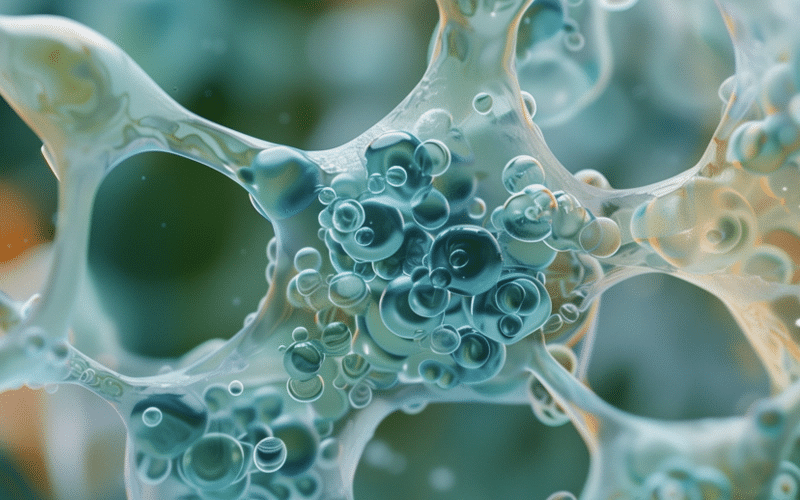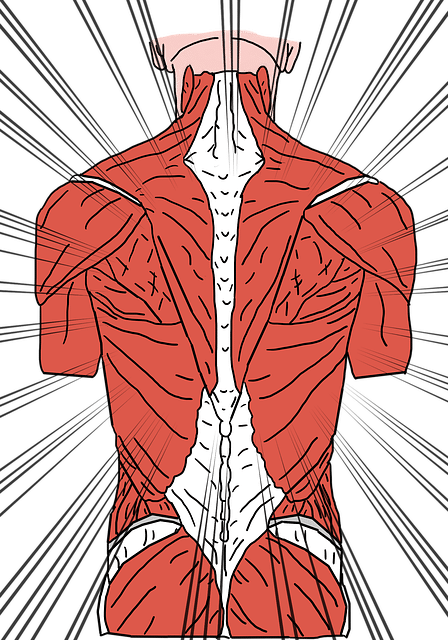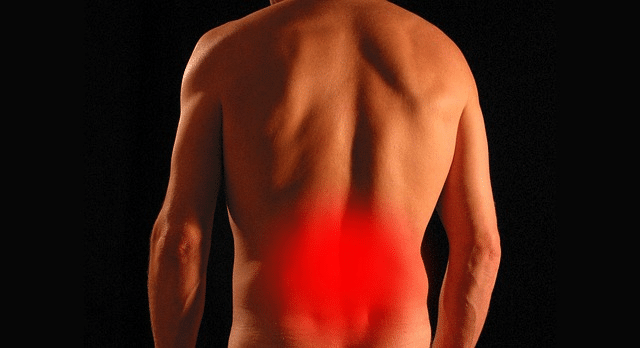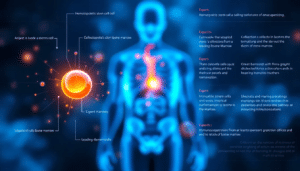In recent years, there has been growing interest in stem cells back pain treatment as a novel approach to managing chronic back aches and injuries and promoting tissue regeneration in the spine. Stem cells, with their unique ability to differentiate into various cell types and self-renew, hold immense promise in regenerative medicine.
Stem cell therapy involves the transplantation or injection of stem cells into damaged or degenerated tissues, aiming to stimulate repair mechanisms and promote healing. This regenerative medicine treatment may help with both pain relief and regeneration of damaged tissues and shows more potential for additional uses as research continues.
Back pain, a prevalent and often debilitating condition, affects millions worldwide, impacting daily activities and quality of life. Traditional treatments like medications and physical therapy may provide temporary relief.
However, stem cell therapy offers a revolutionary solution by targeting the underlying causes of pain, such as disc degeneration and inflammation. Through harnessing the regenerative properties of stem cells, this therapy aims to rebuild damaged tissue and alleviate pain, offering hope to those seeking long-term relief.
Using Stem Cells Back Pain Treatments to Improve Your Life
This article delves into the mechanisms of stem cell therapy, the various procedures involved, and its potential benefits for individuals with back pain. From intradiscal stem cell injections to bone marrow aspirate concentrate, we explore the diverse approaches within regenerative therapy.
Additionally, we examine the clinical evidence supporting stem cell treatment, along with patient experiences and future directions in the field. By shedding light on the transformative potential of stem cell therapy, we aim to pave the way for improved outcomes and enhanced quality of life for those suffering from back pain.
Stem Cell Therapy as a Potential Treatment Option for Back Pain

Back pain is a prevalent and often debilitating condition that affects millions of individuals worldwide, impacting their daily activities, work productivity, and their overall quality of life.
While various treatment options exist, such as medications, physical therapy, and surgery, many individuals continue to experience persistent or recurrent symptoms. In recent years, there has been growing interest in the potential of stem cell therapy as a novel approach to managing back pain and promoting tissue regeneration in the spine.
Stem cell therapy involves the transplantation or injection of stem cells into damaged or degenerated tissues, with the goal of stimulating repair mechanisms and promoting healing. Stem cells are unique cells with the remarkable ability to differentiate into different cell types and self-renew, making them invaluable in regenerative medicine.
In the context of back pain, stem cell therapy offers the potential to address the underlying causes of pain, such as disc degeneration, inflammation, and tissue damage, by harnessing the regenerative properties of stem cells.
This article aims to provide an overview of stem cell therapy for back pain, exploring its mechanisms of action, types of procedures, clinical evidence, patient experiences, and future directions.
By examining the latest research findings and emerging trends in the field, we hope to shed light on the potential of stem cell therapy as a promising treatment option for individuals suffering from back pain, paving the way for improved outcomes and enhanced quality of life.
Causes and Types of Back Pain

Stem Cell Activation: Exosomes derived from mesenchymal stem cells (MSCs) contain growth factors and signaling molecules that can activate hair follicle stem cells, stimulating their proliferation and differentiation. This activation of stem cells promotes the regeneration of hair follicles and the growth of new hair strands.
Angiogenesis Promotion: Exosomes contain angiogenic factors such as vascular endothelial growth factor (VEGF) and fibroblast growth factor (FGF), which stimulate the formation of new blood vessels. Enhanced blood supply to the hair follicles improves nutrient and oxygen delivery, creating a favorable microenvironment for hair growth.
Anti-apoptotic Effects: Exosomes can inhibit apoptosis (cell death) of hair follicle cells by delivering anti-apoptotic factors and microRNAs to target cells. This anti-apoptotic activity protects hair follicles from damage and prolongs the anagen (growth) phase of the hair growth cycle, leading to increased hair growth and density.
Stimulation of Dermal Papilla Cells: Exosomes stimulate dermal papilla cells, which play a crucial role in hair follicle development and hair growth regulation. By delivering growth factors and signaling molecules, exosomes promote the proliferation and activity of dermal papilla cells, facilitating hair follicle growth and maintenance.
Regulation of Hair Follicle Cycling: Exosomes can modulate the activity of signaling pathways involved in the hair growth cycle, such as the Wnt/β-catenin pathway. By regulating the expression of key genes and proteins involved in hair follicle cycling, exosomes promote the transition of hair follicles from the resting (telogen) phase to the growth (anagen) phase, stimulating hair growth.
Reduction of Inflammation: Exosomes possess anti-inflammatory properties and can modulate immune responses in the scalp. By suppressing inflammation and immune reactions that contribute to hair follicle miniaturization and hair loss, exosomes create a conducive environment for hair growth and regeneration.
Potential Benefits of Stem Cell Therapy for Back Pain

Stem cell therapies hold considerable promise as a potential treatment for back pain and back injury, offering several potential benefits which include:
Tissue Regeneration: Stem cells have the unique ability to differentiate into various cell types, including bone, cartilage, and muscle cells. By promoting tissue regeneration, stem cell therapy may help repair damaged or degenerated tissues in the spine, such as intervertebral discs or vertebral bone.
Anti-inflammatory Effects: Stem cells produce anti-inflammatory molecules that can help reduce inflammation in the affected area of the spine. By modulating the immune response, stem cell therapy may alleviate pain and discomfort associated with inflammation-related back conditions.
Pain Relief: Stem cells secrete growth factors and other signaling molecules that can stimulate the body’s natural healing processes and promote pain relief. By targeting the underlying causes of back pain, stem cell therapy may provide long-lasting relief from chronic or recurrent symptoms.
Minimally Invasive: Stem cell therapy for back pain is often performed using minimally invasive techniques, such as injections or implantation procedures. Compared to traditional surgical interventions, stem cell therapy may offer a less invasive alternative with shorter recovery times and reduced risk of complications.
Potential to Delay or Avoid Surgery: For individuals with degenerative spine conditions or injuries, stem cell therapy may offer a non-surgical alternative that can help delay or avoid the need for invasive surgical procedures. By promoting tissue repair and regeneration, stem cell therapy may provide an effective alternative to surgery for certain patients.
Personalized Treatment Approach: Stem cell therapy can be tailored to the individual needs of each patient, taking into account factors such as the severity of back pain, underlying medical conditions, and treatment goals. This personalized approach allows healthcare providers to optimize treatment outcomes and improve patient satisfaction.
Long-term Benefits: While more research is needed to fully understand the long-term effects of stem cell therapy for back pain, early studies and clinical trials have shown promising results. By addressing the underlying causes of back pain and promoting tissue regeneration, stem cell therapy may offer long-lasting benefits for patients seeking relief from chronic or recurrent symptoms.
Overall, stem cell therapy holds significant potential as a promising treatment option for individuals suffering from back pain. As research in this field continues to advance, stem cell therapy may play an increasingly important role in the management of various spine conditions, offering hope for improved outcomes and enhanced quality of life for patients.
How Stem Cells May Repair Damaged Tissues in the Spine

Stem cells offer a promising avenue for repairing damaged tissues in the spine due to their unique regenerative properties and ability to differentiate into various cell types. Here’s how stem cells may help in repairing damaged tissues in the spine:
Differentiation into specialized cells
Stem cells have the remarkable ability to differentiate into different cell types, including bone cells, cartilage cells, and nerve cells. When transplanted into the damaged areas of the spine, stem cells can transform into the specific cell types needed to repair and regenerate the damaged tissues.
Promotion of tissue regeneration
Stem cells secrete growth factors and other signaling molecules that stimulate the body’s natural healing processes. These growth factors can promote the proliferation of healthy cells and encourage the formation of new blood vessels, facilitating tissue regeneration in the damaged areas of the spine.
Anti-inflammatory effects
Inflammation plays a key role in many spine conditions, contributing to tissue damage and pain. For anyone suffering from back pain and back injuries of various types, you know just how much they can affect your daily activities and your ability to live a productive life.
Oftentimes, the typical options for pain relief are delivered in the form of harmful addictive drugs. While these medicines have their place in the treatment of back pain and back injuries, stem cell injections continue to offer an alternative or complementary regenerative therapy option for the relief of back pain from damaged tissue, bone, and nerves.
Stem cells produce anti-inflammatory molecules that can help reduce inflammation in the affected area of the spine, alleviating pain and discomfort and creating a more favorable environment for tissue repair.
Modulation of the immune response

Stem cells can modulate the immune response, suppressing harmful immune reactions and promoting tissue repair. By regulating the activity of immune cells in the damaged tissues of the spine, stem cells can help create an environment conducive to healing and regeneration.
Enhancement of spinal disc health
Intervertebral discs in the spine can degenerate over time, leading to conditions such as degenerative disc disease and disc herniation. Stem cells can help replenish the cells within the discs, promote the production of extracellular matrix components, and improve disc hydration and function, thereby enhancing spinal disc health and reducing the risk of disc-related problems.
Overall, stem cells offer a promising therapeutic approach for repairing damaged tissues in the spine by promoting tissue regeneration, reducing inflammation, modulating the immune response, and enhancing spinal disc health.
While more research is needed to fully understand the pain relief and healing mechanisms underlying stem cell therapy for spinal repair, early studies, and clinical trials have shown promising results, paving the way for the development of innovative treatments for spine conditions.
Types of Stem Cell Procedures for Back Pain

Intradiscal Stem Cell Injections
Intradiscal stem cell injections involve the direct injection of stem cells into the intervertebral discs of the spine. This procedure is commonly used to treat conditions such as degenerative disc disease and disc herniation, where the discs have degenerated or become damaged.
The injected stem cells can promote tissue regeneration within the discs, improve disc hydration and function, and alleviate symptoms such as pain and stiffness.
Bone Marrow Aspirate Concentrate (BMAC) Therapy
BMAC therapy involves the extraction of bone marrow from the patient’s hip or pelvis, followed by the concentration of stem cells from the extracted bone marrow. The concentrated stem cells are then injected into the damaged or degenerated areas of the spine, where they can promote tissue repair and regeneration, reduce inflammation, and alleviate pain.
Mesenchymal Stem Cell (MSC) Therapy
Mesenchymal stem cells (MSCs) are a type of adult stem cell that can differentiate into bone, cartilage, and fat cells. MSC therapy for back pain typically involves the isolation and expansion of MSCs from sources such as bone marrow or adipose tissue.
The expanded MSCs are then injected into the affected areas of the spine, where they can promote tissue regeneration, modulate the immune response, and reduce inflammation, leading to pain relief and improved function.
Induced Pluripotent Stem Cell (iPSC) Therapy
Induced pluripotent stem cells (iPSCs) are generated by reprogramming adult cells, such as skin cells or blood cells, into a pluripotent state. iPSC therapy holds the potential for treating back pain by providing a source of patient-specific stem cells that can be differentiated into various cell types for tissue repair and regeneration. However, iPSC therapy is still in the early stages of research and development for back pain treatment.
Frequently Asked Questions

How do stem cells help alleviate back pain?
Stem cells have the ability to differentiate into various cell types and promote tissue regeneration. When injected into the damaged areas of the spine, stem cells can help repair damaged tissues, reduce inflammation, and alleviate pain associated with conditions such as degenerative disc disease, disc herniation, and spinal stenosis.
Is stem cell therapy for back pain safe?
Stem cell therapy for back pain is considered safe when performed by qualified healthcare professionals using standard protocols. However, as with any medical procedure, there are potential risks and side effects, such as infection, bleeding, or allergic reactions. Patients should discuss the potential risks and benefits of stem cell therapy with their healthcare provider before undergoing treatment.
How long does it take to see results from stem cell therapy for back pain?
The timeline for experiencing results from stem cell therapy for back pain can vary depending on factors such as the severity of the condition, the type of stem cell procedure used, and individual patient factors. Some patients may experience improvements in pain and function within a few weeks to months after treatment, while others may require more time to see significant benefits.
Are there any restrictions or limitations after undergoing stem cell therapy for back pain?
Patients may be advised to avoid strenuous activities or heavy lifting for a certain period after undergoing stem cell therapy for back pain to allow for proper healing and recovery. It’s essential to follow the post-procedure instructions provided by your healthcare provider to optimize treatment outcomes and minimize the risk of complications.
Will Stem Cell Therapy Help You Address Your Back Pain Symptoms and Live a Happier Life?

Stem cell therapy holds significant promise as a potential treatment option for individuals suffering from back pain. By harnessing the regenerative properties of stem cells, healthcare providers can target the underlying causes of back pain and promote tissue repair and regeneration in the spine.
From intradiscal stem cell injections to bone marrow aspirate concentrate therapy, there are various types of stem cell procedures available to address different spine conditions and inuries.
While stem cell therapy for back pain shows promising results in clinical studies and patient experiences, further research is needed to fully understand its long-term effectiveness and safety.
Additionally, ongoing advancements in stem cell technology and regenerative medicine may lead to improved treatment outcomes and expanded options for individuals with back pain. After spine, back, knee, and hip surgery many patients need opioid pain medications.
Overall, stem cell therapy offers a potential alternative to traditional treatments for back pain, such as medications or surgery, and may provide long-lasting relief and improved quality of life for patients. As research in this field continues to evolve, stem cell therapy has the potential to revolutionize the management of back pain and pave the way for innovative approaches to spine care in the future.


